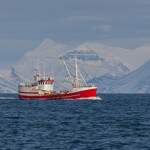ASMI requests federal aid to cushion losses in US-China trade war
The Alaska Seafood Marketing Institute (ASMI) is crossing its fingers that its request goes through for several million dollars in federal aid to defray costs of the trade war between U.S. President Donald Trump’s administration and China.
ASMI, a state-run entity, has requested USD 9 million (EUR 7.9 million) over three years as tariffs threaten to undermine the market for Alaskan seafood in China. The request was submitted to the Agricultural Trade Promotion (ATP), a U.S. Department of Agriculture program designed in part to mitigate the adverse effects of tariffs.
The organization has been getting around USD 4.25 (EUR 3.74) million a year in federal aid for over a decade, according to Jeremy Woodrow, ASMI’s communications director and current interim executive director. This new aid money would be on top of that.
Alexa Tonkovich, ASMI's outgoing executive director, reviewed some of the funding challenges she faced in an interview with SeafoodSource. Tonkovich spent nine years with the organization and the work that was done to alleviate the issues caused by continued budget cuts.
ASMI should know the amount of the award in January, but the figure could be less than the requested USD 3 million (EUR 2.6 million) annually.
“We do understand that there are multiple agencies vying for these funds, and so we definitely aren’t counting our chickens before they hatch,” Woodrow said. “We’re hopeful we’ll receive some ATP funding, but we don’t how much that will be and therefore exactly how we’ll apply those funds.”
While no one is sure how much the new tariffs will cost Alaska’s seafood industry, they come at a tough time for ASMI. Beyond the challenges of staying competitive in China, the agency has come to the end of general fund state dollars in an Alaska strapped by low oil prices.
“We used to receive a large share of state general fund dollars. That’s has ramped down over several years and zeroes out this year,” Woodrow added.
Woodrow added the details of the government aid will determine exactly how the money will be spent.
“It depends on the amount, where it can be spent, and the timeline to spend the funds. We’ll definitely look at increasing consumer awareness and relations in China,” he said. “There are also opportunities to look at other new markets, whether in Asia or elsewhere. We can also look at secondary markets where we already market Alaska seafood and see if we should step up our programs there.”






Share